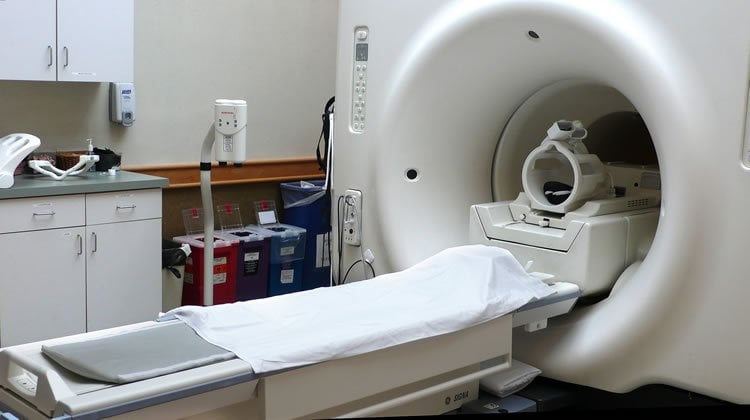Summary: Researchers have developed a method using MRI to identify when HIV is still present in the brain, despite effective drug treatment.
Source: UCL.
Scientists at UCL have developed a way to use MRI scans to help identify when HIV is persisting in the brain despite effective drug treatment.
The study, published in Clinical Infectious Diseases and funded by Wellcome, shows that patients can have HIV in the brain even when the disease is kept under control by treatment.
“Before we had effective treatments for HIV, AIDS often led to dementia and other problems in the brain,” explains senior author Professor Ravi Gupta (UCL Infection & Immunity), who is also an Honorary Consultant in Infectious Diseases at The Hospital for Tropical Diseases, UCLH NHS Foundation Trust. “Thankfully this is less common now that we can treat HIV, but up to half of HIV patients still report cognitive problems. We see evidence that HIV has spread to the brain in around ten to fifteen percent of these patients, but in most cases the symptoms are down to other causes. At the moment we have to perform a lumbar puncture to confirm this, which involves inserting a needle into the back to draw out the spinal fluid and test it for HIV. This is quite an invasive procedure that requires patients to stay in hospital for several hours. Our new study shows that MRI scans could help to identify high-risk individuals for further follow-up tests.”
The team looked at data from 146 HIV patients who were investigated for cognitive problems between 2011 and 2015. There was evidence that HIV was active in the brain in 22 patients (15%), and patients whose brains showed definite signs of change in the white matter were ten times more likely to have HIV in the brain than those with normal white matter appearances.
These changes in the brain, called diffuse white matter signal abnormalities, are linked to cognitive problems and can be triggered by inflammation in the brain caused by HIV infection.

“HIV treatments have come a long way, but patients whose HIV is suppressed by drugs can still have cognitive problems due to HIV related inflammation,” says Prof Gupta. “MRI scans can help to diagnose these patients, whether showing an elevated risk of HIV-related problems or finding a different cause that can then be treated. Where HIV has spread to the brain, we can change the treatment regime to add drugs that cross the blood-brain barrier more effectively to control the infection.”
Source: Harry Dayantis – UCL
Image Source: NeuroscienceNews.com image is adapted from the UCL press release.
Original Research: Full open access research for “Diffuse White Matter Signal Abnormalities on Magnetic Resonance Imaging Are Associated With Human Immunodeficiency Virus Type 1 Viral Escape in the Central Nervous System Among Patients With Neurological Symptoms” by Ruthiran Kugathasan, Dami A. Collier, Lewis J. Haddow, Kate El Bouzidi, Simon G. Edwards, Jonathan D. Cartledge, Robert F. Miller, and Ravindra K. Gupta in Clinical Infectious Diseases. Published online March 13 2017 doi:10.1093/cid/cix035
[cbtabs][cbtab title=”MLA”]UCL “MRI Scans Can Help Spot HIV in the Brain.” NeuroscienceNews. NeuroscienceNews, 13 March 2017.
<https://neurosciencenews.com/mri-hiv-neuroscience-6239/>.[/cbtab][cbtab title=”APA”]UCL (2017, March 13). MRI Scans Can Help Spot HIV in the Brain. NeuroscienceNew. Retrieved March 13, 2017 from https://neurosciencenews.com/mri-hiv-neuroscience-6239/[/cbtab][cbtab title=”Chicago”]UCL “MRI Scans Can Help Spot HIV in the Brain.” https://neurosciencenews.com/mri-hiv-neuroscience-6239/ (accessed March 13, 2017).[/cbtab][/cbtabs]
Abstract
Diffuse White Matter Signal Abnormalities on Magnetic Resonance Imaging Are Associated With Human Immunodeficiency Virus Type 1 Viral Escape in the Central Nervous System Among Patients With Neurological Symptoms
Background.
Human immunodeficiency virus type 1 (HIV-1) can replicate independently in extravascular compartments such as the central nervous system, resulting in either cerebrospinal fluid (CSF) discordance (viral load [VL] in CSF 0.5 log10 copies HIV-1 RNA greater than plasma VL) or escape (detection of HIV VL >50 copies/mL in CSF in patients with suppressed plasma VL <50 copies/mL). Both discordance and escape may be associated with neurological symptoms. We explored risk factors for CSF discordance and escape in patients presenting with diverse neurological problems.
Methods.
HIV-infected adult patients undergoing diagnostic lumbar puncture (LP) at a single center between 2011 and 2015 were included in the analysis. Clinical and neuroimaging variables associated with CSF discordance/escape were identified using multivariate logistic regression.
Results.
One hundred forty-six patients with a median age of 45.3 (interquartile range [IQR], 39.6–51.5) years underwent 163 LPs. Median CD4 count was 430 (IQR, 190–620) cells/µL. Twenty-four (14.7%) LPs in 22 patients showed CSF discordance, of which 10 (6.1%) LPs in 9 patients represented CSF escape. In multivariate analysis, both CSF discordance and escape were associated with diffuse white matter signal abnormalities (DWMSAs) on cranial magnetic resonance imaging (adjusted odds ratio, 10.3 [95% confidence interval {CI}, 2.3–45.0], P = .007 and 56.9 [95% CI, 4.0–882.8], P = .01, respectively). All 7 patients with CSF escape (10 LPs) had been diagnosed with HIV >7 years prior to LP, and 6 of 6 patients with resistance data had documented evidence of drug-resistant virus in plasma.
Conclusions.
Among patients presenting with diverse neurological problems, CSF discordance or escape was observed in 15%, with treatment-experienced patients dominating the escape group. DWMSAs in HIV-infected individuals presenting with neurological problems should raise suspicion of possible CSF discordance/escape.
“Diffuse White Matter Signal Abnormalities on Magnetic Resonance Imaging Are Associated With Human Immunodeficiency Virus Type 1 Viral Escape in the Central Nervous System Among Patients With Neurological Symptoms” by Ruthiran Kugathasan, Dami A. Collier, Lewis J. Haddow, Kate El Bouzidi, Simon G. Edwards, Jonathan D. Cartledge, Robert F. Miller, and Ravindra K. Gupta in Clinical Infectious Diseases. Published online March 13 2017 doi:10.1093/cid/cix035






